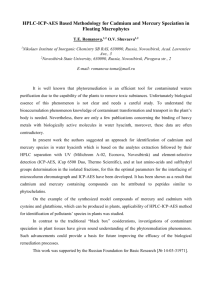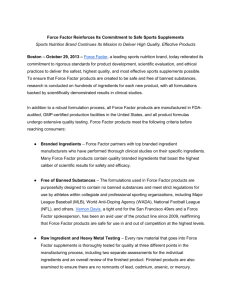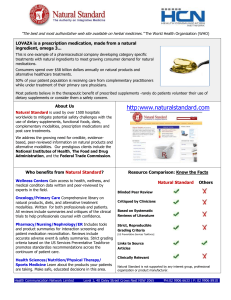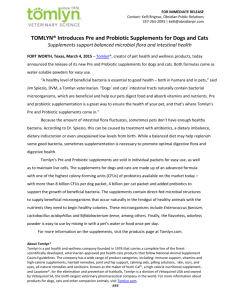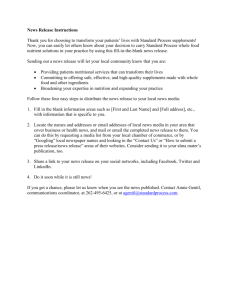COMMISSION REGULATION (EC) No 629/2008 of 2 July 2008
advertisement
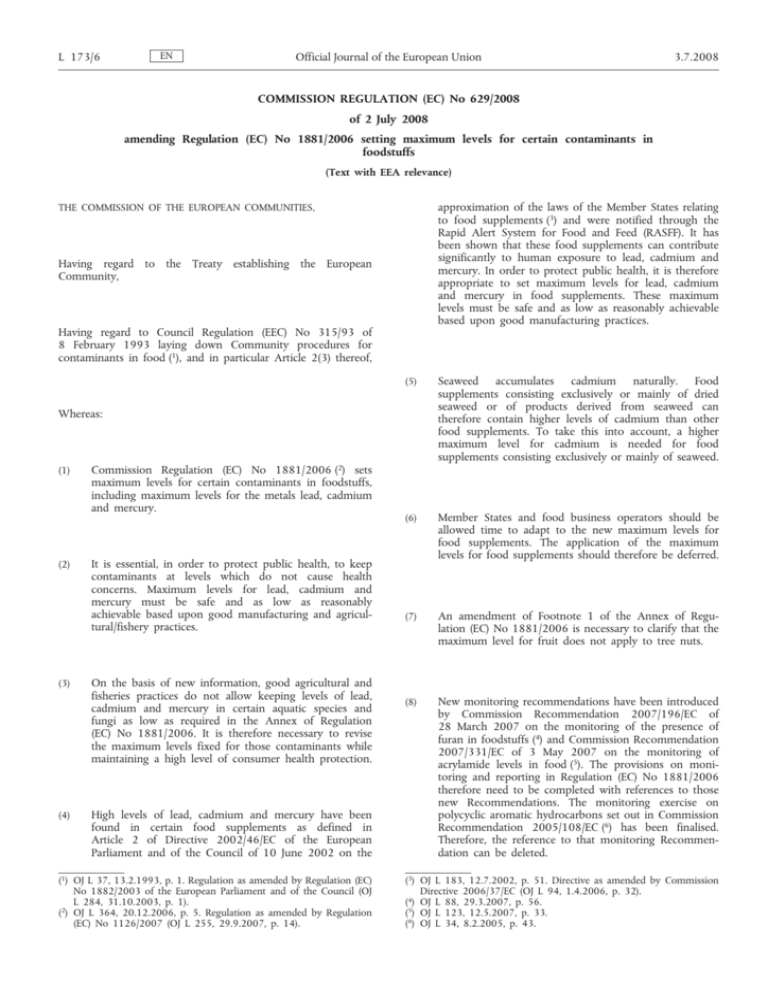
L 173/6 EN Official Journal of the European Union 3.7.2008 COMMISSION REGULATION (EC) No 629/2008 of 2 July 2008 amending Regulation (EC) No 1881/2006 setting maximum levels for certain contaminants in foodstuffs (Text with EEA relevance) approximation of the laws of the Member States relating to food supplements (3) and were notified through the Rapid Alert System for Food and Feed (RASFF). It has been shown that these food supplements can contribute significantly to human exposure to lead, cadmium and mercury. In order to protect public health, it is therefore appropriate to set maximum levels for lead, cadmium and mercury in food supplements. These maximum levels must be safe and as low as reasonably achievable based upon good manufacturing practices. THE COMMISSION OF THE EUROPEAN COMMUNITIES, Having regard to the Treaty establishing the European Community, Having regard to Council Regulation (EEC) No 315/93 of 8 February 1993 laying down Community procedures for contaminants in food (1), and in particular Article 2(3) thereof, (5) Seaweed accumulates cadmium naturally. Food supplements consisting exclusively or mainly of dried seaweed or of products derived from seaweed can therefore contain higher levels of cadmium than other food supplements. To take this into account, a higher maximum level for cadmium is needed for food supplements consisting exclusively or mainly of seaweed. (6) Member States and food business operators should be allowed time to adapt to the new maximum levels for food supplements. The application of the maximum levels for food supplements should therefore be deferred. (7) An amendment of Footnote 1 of the Annex of Regulation (EC) No 1881/2006 is necessary to clarify that the maximum level for fruit does not apply to tree nuts. (8) High levels of lead, cadmium and mercury have been found in certain food supplements as defined in Article 2 of Directive 2002/46/EC of the European Parliament and of the Council of 10 June 2002 on the New monitoring recommendations have been introduced by Commission Recommendation 2007/196/EC of 28 March 2007 on the monitoring of the presence of furan in foodstuffs (4) and Commission Recommendation 2007/331/EC of 3 May 2007 on the monitoring of acrylamide levels in food (5). The provisions on monitoring and reporting in Regulation (EC) No 1881/2006 therefore need to be completed with references to those new Recommendations. The monitoring exercise on polycyclic aromatic hydrocarbons set out in Commission Recommendation 2005/108/EC (6) has been finalised. Therefore, the reference to that monitoring Recommendation can be deleted. (1) OJ L 37, 13.2.1993, p. 1. Regulation as amended by Regulation (EC) No 1882/2003 of the European Parliament and of the Council (OJ L 284, 31.10.2003, p. 1). (2) OJ L 364, 20.12.2006, p. 5. Regulation as amended by Regulation (EC) No 1126/2007 (OJ L 255, 29.9.2007, p. 14). (3) OJ L 183, 12.7.2002, p. 51. Directive as amended by Commission Directive 2006/37/EC (OJ L 94, 1.4.2006, p. 32). (4) OJ L 88, 29.3.2007, p. 56. (5) OJ L 123, 12.5.2007, p. 33. (6) OJ L 34, 8.2.2005, p. 43. Whereas: (1) (2) (3) (4) Commission Regulation (EC) No 1881/2006 (2) sets maximum levels for certain contaminants in foodstuffs, including maximum levels for the metals lead, cadmium and mercury. It is essential, in order to protect public health, to keep contaminants at levels which do not cause health concerns. Maximum levels for lead, cadmium and mercury must be safe and as low as reasonably achievable based upon good manufacturing and agricultural/fishery practices. On the basis of new information, good agricultural and fisheries practices do not allow keeping levels of lead, cadmium and mercury in certain aquatic species and fungi as low as required in the Annex of Regulation (EC) No 1881/2006. It is therefore necessary to revise the maximum levels fixed for those contaminants while maintaining a high level of consumer health protection. 3.7.2008 EN Official Journal of the European Union (9) Regulation (EC) No 1881/2006 should therefore be amended accordingly. (10) The measures provided for in this Regulation are in accordance with the opinion of the Standing Committee on the Food Chain and Animal Health, L 173/7 findings on acrylamide and furan as specified in Commission Recommendation 2007/196/EC (46) and Commission Recommendation 2007/331/EC (47). ___________ (44) OJ L 199, 21.7.2006, p. 21. (45) OJ L 322, 22.11.2006, p. 24. (46) OJ L 88, 29.3.2007, p. 56. (47) OJ L 123, 12.5.2007, p. 33.’ HAS ADOPTED THIS REGULATION: Article 1 2. The Annex is amended in accordance to the Annex to this Regulation. Article 2 Regulation (EC) No 1881/2006 is amended as follows: 1. In Article 9, paragraph 3 is replaced by the following: ‘3. Member States should report to the Commission findings on aflatoxins, dioxins, dioxin-like PCBs, nondioxin-like PCBs as specified in Commission Decision 2006/504/EC (44) and Commission Recommendation 2006/794/EC (45). Member States should report to EFSA This Regulation shall enter into force on the 20th day following its publication in the Official Journal of the European Union. The maximum levels laid down in points 3.1.18, 3.2.19, 3.2.20 and 3.3.3 of the Annex shall apply from 1 July 2009. They shall not apply to products lawfully placed on the market before 1 July 2009. The burden of proving when the products were placed on the market shall be borne by the food business operator. This Regulation shall be binding in its entirety and directly applicable in all Member States. Done at Brussels, 2 July 2008. For the Commission Androulla VASSILIOU Member of the Commission EN L 173/8 Official Journal of the European Union 3.7.2008 ANNEX The Annex to Regulation (EC) No 1881/2006 is amended as follows: (1) In Subsection 3.1 (Lead), point 3.1.11 is replaced by the following and a new point 3.1.18 is added: ‘3.1.11 Brassica vegetables, leaf vegetables and the following fungi (27): Agaricus bisporus (common mushroom), Pleurotus ostreatus (Oyster mushroom), Lentinula edodes (Shiitake mushroom) 0,30 3.1.18 Food supplements (*) 3,0 (*) The maximum level applies to the food supplements as sold.’ (2) Subsection 3.2. (Cadmium) is replaced by the following: ‘3.2 Cadmium 3.2.1 Meat (excluding offal) of bovine animals, sheep, pig and poultry (6) 0,050 3.2.2 Horsemeat, excluding offal (6) 0,20 ( 6) 0,50 3.2.3 Liver of bovine animals, sheep, pig, poultry and horse 3.2.4 Kidney of bovine animals, sheep, pig, poultry and horse (6) 1,0 3.2.5 Muscle meat of fish (24) (25), excluding species listed in points 3.2.6, 3.2.7 and 3.2.8 0,050 3.2.6 Muscle meat of the following fish (24) (25): bonito (Sarda sarda) common two-banded seabream (Diplodus vulgaris) eel (Anguilla anguilla) grey mullet (Mugil labrosus labrosus) horse mackerel or scad (Trachurus species) louvar or luvar (Luvarus imperialis) mackerel (Scomber species) sardine (Sardina pilchardus) sardinops (Sardinops species) tuna (Thunnus species, Euthynnus species, Katsuwonus pelamis) wedge sole (Dicologoglossa cuneata) 0,10 3.2.7 Muscle meat of the following fish (24) (25): bullet tuna (Auxis species) 0,20 3.2.8 Muscle meat of the following fish (24) (25): anchovy (Engraulis species) swordfish (Xiphias gladius) 0,30 3.2.9 Crustaceans, excluding brown meat of crab and excluding head and thorax meat of lobster and similar large crustaceans (Nephropidae and Palinuridae) (26) 0,50 3.2.10 Bivalve molluscs (26) 1,0 3.2.11 Cephalopods (without viscera) (26) 1,0 3.2.12 Cereals excluding bran, germ, wheat and rice 0,10 3.2.13 Bran, germ, wheat and rice 0,20 3.2.14 Soybeans 0,20 3.2.15 Vegetables and fruit, excluding leaf vegetables, fresh herbs, fungi, stem vegetables, root vegetables and potatoes (27) 0,050 3.7.2008 EN Official Journal of the European Union L 173/9 3.2.16 Stem vegetables, root vegetables and potatoes, excluding celeriac (27). For potatoes the maximum level applies to peeled potatoes. 0,10 3.2.17 Leaf vegetables, fresh herbs, celeriac and the following fungi (27): Agaricus bisporus (common mushroom), Pleurotus ostreatus (Oyster mushroom), Lentinula edodes (Shiitake mushroom) 0,20 3.2.18 Fungi, excluding those listed in point 3.2.17 (27) 1,0 3.2.19 Food supplements (*) excl. food supplements listed in point 3.2.20 1,0 3.2.20 Food supplements (*) consisting exclusively or mainly of dried seaweed or of products derived from seaweed 3,0 (*) The maximum level applies to the food supplements as sold.’ (3) In Subsection 3.3 (Mercury), point 3.3.2 is replaced by the following and a new point 3.3.3 is added: ‘3.3.2 Muscle meat of the following fish (24) (25): anglerfish (Lophius species) Atlantic catfish (Anarhichas lupus) bonito (Sarda sarda) eel (Anguilla species) emperor, orange roughy, rosy soldierfish (Hoplostethus species) grenadier (Coryphaenoides rupestris) halibut (Hippoglossus hippoglossus) kingklip (Genypterus capensis) marlin (Makaira species) megrim (Lepidorhombus species) mullet (Mullus species) pink cusk eel (Genypterus blacodes) pike (Esox lucius) plain bonito (Orcynopsis unicolor) poor cod (Tricopterus minutes) Portuguese dogfish (Centroscymnus coelolepis) rays (Raja species) redfish (Sebastes marinus, S. mentella, S. viviparus) sail fish (Istiophorus platypterus) scabbard fish (Lepidopus caudatus, Aphanopus carbo) seabream, pandora (Pagellus species) shark (all species) snake mackerel or butterfish (Lepidocybium flavobrunneum, Ruvettus pretiosus, Gempylus serpens) sturgeon (Acipenser species) swordfish (Xiphias gladius) tuna (Thunnus species, Euthynnus species, Katsuwonus pelamis) 1,0 3.3.3 Food supplements (*) 0,10 (*) The maximum level applies to the food supplements as sold.’ (4) In footnote (1) the following sentence is added: ‘Tree nuts are not covered by the maximum level for fruit.’ (5) Footnote (8) is replaced by the following: ‘(8) Foodstuffs listed in this category as defined in Commission Directive 2006/141/EC (OJ L 401, 30.12.2006, p. 1).’

